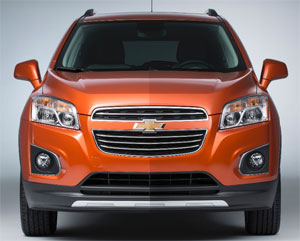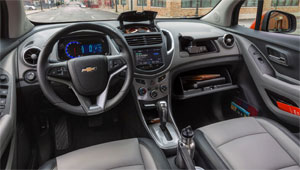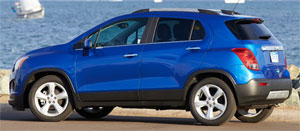2015 Chevrolet Trax
Chevrolet is well known for its full-size SUVs like this Tahoe. But, it’s really small utes that are fast becoming today’s big deal. The Nissan Juke, MINI Countryman, and Buick Encore are already out, with more coming like the Honda HR-V, Jeep Renegade, and our focus this week, the Chevrolet Trax. Now, Chevy is no stranger to tiny utes. But, their last one, the Tracker built with Suzuki, was less than the best. So let’s see the new Trax is on the right track.
Utility vehicles are coming in ever more shapes and sizes these days, so love them or hate them; they’re not going away anytime soon. This 2015 Chevrolet Trax plays into a segment that is ripe for explosive growth: sub-compact crossovers.
While most efforts so far have been luxury minded, like the Mini Cooper Countryman, and Buick Encore, with which this Trax shares a platform, more mainstream brands are now joining the downsizing. And it’s about time, as we think the Encore’s size would work for Chevy from the get go.
 And actually it has been, as the South Korean made Trax is already sold in over 60 global markets. It’s just new to Chevy dealers here.
And actually it has been, as the South Korean made Trax is already sold in over 60 global markets. It’s just new to Chevy dealers here.
Mechanically, the Trax is nearly a clone of the Encore, including front-wheel-drive being standard with all-wheel-drive optional. Power comes from the same “little engine that almost can”. Lifted from the Chevy Sonic subcompact, it’s a 1.4-liter I4 turbo with 138-horsepower and 148 lb-ft. of torque, attached to a 6-speed automatic transmission. Also from Sonic is the MacPherson strut front suspension, and compound crank torsion beam under the rear.
On both city streets and the sweeping canyons east of San Diego, where we got our first drive, the suspension tuning proved fully competent; similar to Encore; not sporty, not soft, but a good middle ground. Ride quality is pretty good for a short wheelbase vehicle, until the roads get really choppy.
The all-wheel-drive system is a fully automatic on-demand system. Sending power rearward when slip is detected, which does include on tight turns. Curb weight is as much as 3,300 pounds with all-wheel-drive.
On the technology front, the Trax is fully up to speed with a 7-inch MyLink display in the center stack, Siri Eyes Free connectivity, standard keyless entry; and optional remote start. Like all newest GM’s, OnStar 4G LTE with built-in WiFi is standard, as is a back-up camera; though navigation, by way of the BringGo app is optional.
 The instrument panel is more Sonic than Encore with a large, round, motorcycle style tachometer on the left, and a rectangular digital display right for speed and more. The 3-spoke steering wheel has nicely integrated controls; and the overall fit-and-finish of the interior seems perfectly fine for a Chevy price point.
The instrument panel is more Sonic than Encore with a large, round, motorcycle style tachometer on the left, and a rectangular digital display right for speed and more. The 3-spoke steering wheel has nicely integrated controls; and the overall fit-and-finish of the interior seems perfectly fine for a Chevy price point.
A full complement of 3 in the back seat would be uncomfortable for all parties involved, but both leg and knee room were adequate for 2 adults; reliefs cut into the front seatbacks help a lot. Up front, there’s a good amount of room as well, but seats are narrow and you still sit very upright.
As for cargo, rear seatbacks fold 60/40, and the front passenger seat folds flat as well, for longer items. At 18.7 cubic-ft., rear cargo space is larger than both the Nissan Juke and Jeep Renegade, 48.4 cubic-ft. with the seat backs folded.
And there’s a wealth of small item storage bins throughout the interior. 10-airbags are standard, including rear seat-mounted thorax bags.
On the outside, all of the current Chevrolet design cues are here; dual-port grille, smooth body sides with rounded fenders, and a gently sloping rear with well integrated spoiler that extends down the sides of the back glass, and stacked tail lamps.
 It’s a smooth design with plenty of curves, a fairly aggressive stance, and enough glass for fine visibility. Body lowers are covered in plastic; and simulated skid plate’s front and rear hint at capabilities that are probably best left untested.
It’s a smooth design with plenty of curves, a fairly aggressive stance, and enough glass for fine visibility. Body lowers are covered in plastic; and simulated skid plate’s front and rear hint at capabilities that are probably best left untested.
16-inch wheels are standard, with the top trim model getting 18’s. Wheelbase of just 100.6-inches, and a front track of 60.6 inches makes for a tidy package. Overall length comes in at 168.5-inches; ground clearance is a good 6.2-inches.
Government Fuel Economy Ratings for a front-wheel-drive Trax are 26-City, 34-Highway, and 29-Combined. Sending power to all 4 wheels will lower those numbers to 24-city, 31-Highway, and 27-Combined. That’s still good for an above average Energy Impact Score of 11.4-barrels of annual oil use with CO2 emissions of 5.1-tons.
Pricing follows an affordable Chevrolet formula starting at $20,995. All-wheel-drive adds $1,500 more, which makes it the least expensive all-wheel-drive Chevrolet you can buy. A base Encore stickers for 4-grand more.
So for 2015, GM morphs the Buick Encore into the Chevrolet Trax, and fortunately all of the competency is left fully intact. The Encore was a much bigger hit than expected, so this one will certainly have higher expectations. But, we think the Trax is off on the right track to fully meet them.
Specifications
- Engine: 1.4 liter
- Horsepower: 138
- Torque: 148 lb-ft.
- EPA: 26 mpg city/ 34 mpg highway
- Energy Impact: 11.4 barrels of oil/yr
- CO2 Emissions: 5.1 tons/yr
2025 Infiniti QX80
Infiniti’s Flagship SUV Sets A Course For Extravagance
This full-size Infiniti QX80 started out as the QX56, a hastily rebadged version of Nissan’s truck-based Armada full-size utility. That was in the early 2000s when the luxury SUV craze was exploding. It wasn’t as much as a game-changer, as it was “try to keep upper”. Now, this new QX80, Infiniti is promising to “Reimagine the luxury SUV”. Let’s see if Infiniti has turned their imaginations into reality.
Well, if over the top is what Infiniti was shooting for in the all-new 2025 QX80, mission accomplished. There’s an overall feeling of extravagance here that we haven’t experienced from Infiniti in quite some time.
It’s not just the open pore ash wood trim with aluminum inlays, 24-speaker audio, and plush quilted leather seating; there’s also nicely integrated ambient lighting, a massive glass roof, plenty of tech, lots of active driving assistance, and even chilled center console storage. Forward of that is a dual touchscreen setup; the top 14.3-inch touchscreen for infotainment sits next to the digital gauge display in a single housing; while just below, there’s a 9-inch one for climate controls.
You are reminded this is still a body-on-frame utility the moment you have to climb up into the cockpit, but there’s also the commanding view of the road that comes with that. Captain’s chairs are standard for the second row, but a three-place bench is optional with all trims except for top Autograph which comes exclusively with these climate-controlled massaging chairs, along with a touchscreen control panel. The third-row experience is great, too, with heated leather seating, and adult size room for three.
Now, there is a whole new experience coming from under the hood. The last gen’s V8 has been replaced with a new twin-turbo 3.5-liter V6 rated at 450 horsepower, 50 over the V8. More notably, torque is up by more than 100 lb-ft to 516. Transmission is a nine-speed automatic, two more gears than last year, with rear-wheel drive standard, four-wheel drive an option. Max tow rating is 8,500-lbs.
And at the test track, it did pull strongly off the line, getting up to speed in a hurry with the 0-60 sprint taking just 6.3 seconds. There is roughly 3 tons of weight to push through the quarter-mile, but that twin-turbo does it well, finishing in 14.7 seconds at 95 mph. Gear changes are incredibly smooth, while not hindering acceleration in any way.
It's an impressive looking utility from any angle.
In panic braking runs, there was some fade and a considerable amount of nosedive, but our average stopping distance of 115 feet is not bad for a vehicle as big and heavy as the QX80. Last gen, the QX80 moved from the Titan truck platform to the global Patrol SUV chassis, which shifted the vibe from budget Escalade to Lexus LX fighter. The attending improvement in ride and handling was the real bonus, and that largely continues for this gen with air suspension and Dynamic Digital Dampers on all but base QX80s. While we could certainly feel all that weight through our cone course, body roll was well-controlled and without significant oversteer or understeer.
It’s an impressive looking utility from any angle, starting right up front with the big “bamboo forest” grille. The overall shape is boxy, but all body panels are smooth; and for better or worse, Infiniti joins the flush door handle fad. Look for its “Artistry In Motion” design theme to work its way down through the rest of the Infiniti lineup. All QX80s ride on 22-inch wheels except for base Pure trim which makes do with 20s.
A full power play includes standard motion-activated rear liftgate and power operation of both second and third row seats, expanding cargo capacity from 22 cu-ft behind the third row to 59 behind the second, and a max of 101.0 cu-ft with both rows folded.
Government Fuel Economy Ratings with four-wheel-drive are not great: 16 city, 19 highway and 17 combined. We averaged 18.6 mpg of premium. That’s a much worse than average Energy Impact Score, using 17.5 barrels of oil annually, with 8.6 tons of CO2 emissions.
Driving such a PUREly LUXEurious SENSORY overload, you’ll probably be expecting people to want your AUTOGRAPH, which we’re guessing is how Infiniti came up with their grade structure; pricing starts with Pure at $84,445 and climbs to $112,590 for Autograph.
The 2025 Infiniti QX80 is a massive SUV that delivers massive amounts of power and luxury. They aimed for the moon here and have clearly blasted themselves into a much more competitive orbit in the big buck, big hauler, sport-utility galaxy.
Specifications
As Tested
- Engine: 3.5-liter twin-turbo V6
- Transmission: 9-speed automatic
- Horsepower: 450
- Torque: 516 lb-ft.
- EPA: 16 City | 19 Highway | 17 Combined
- 0-60 mph: 6.3 seconds
- 1/4 Mile: 14.7 seconds at 95 mph
- Braking, 60-0 (avg.): 115 feet
- MW Fuel Economy: 18.6 mpg (Premium)
























































